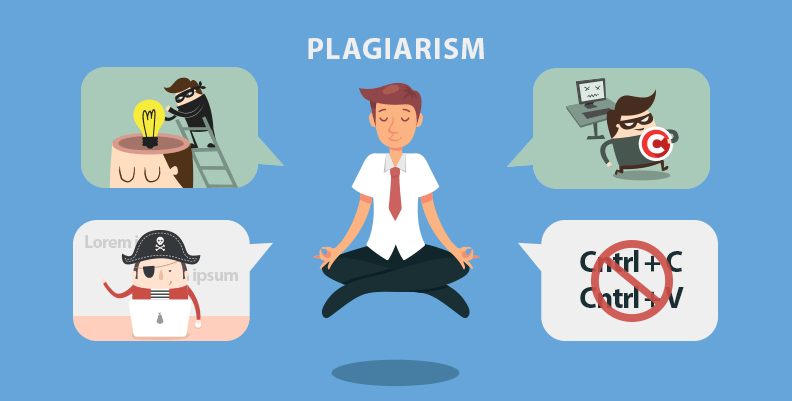Almost each of us has once been writing an academic paper and knows what it is to look for resources and organize them into a coherent research. Unfortunately, even if a student has browsed hundreds of books and online resources and was composing his research himself, this student is not insured from unintentional academic plagiarism. How disappointing it is to be charged for cheating without doing that! That is why it is necessary to know what academic plagiarism is, so as not to get into a trap occasionally.
Academic plagiarism definition
Academic plagiarism is the act of copying, stealing or using someone else’s quotes without acknowledgment of their author. Another definition by Thomas Mallon states that it is a deliberate attempt to cheat the reader representing or appropriating another person’s words as your own ones.
In any case, plagiarism can be compared with theft, purloin, illegal action, cheat etc. Any of these efforts require punishment that sometimes can be rather tough. Modern educational institutions try to struggle the notion of plagiarism by explaining what plagiarism is and how severe consequences of its use might be.
Intentional and unintentional plagiarism
The plagiarism cases are rather different as well as the volumes of the plagiarized text. At the same time, it is important to consider whether the text was copied or paraphrased with the definite intention to cheat or accidentally. That is why scientists have classified plagiarism cases into two types:
- Intentional plagiarism is a plagiarism type when a writer fully realizes about passing off someone else’s thoughts and does it deliberately. The most common examples of intentional plagiarizing are presentation another student’s work as your own creation, copying the text of the academic paper from the Internet or book without marking it as a citation or quote, asking someone to write a paper, making instant translation without mentioning the author etc.
- Unintentional plagiarism occurs in cases when a writer or researcher uses the ideas, words, thoughts or phrases of other authors without realizing that this is not his or her own creation or failing to quote or cite because of unawareness how to do that properly. It happens that researchers look through many sources, read other people’s ideas but forget about the exact place where they have learned it. It seems that this information is their own unique idea, so the examples of unintentional plagiarism are quite similar: poor paraphrasing, poor quoting and citing etc.
Of course, unawareness is not a reason not to be accused of plagiarizing, but it may be a circumstance not to make the punishment too severe. However, it is not the only classification of plagiarism. Let’s consider other plagiarism types to be armed with the knowledge what each of them is and how it can be avoided.
Types of plagiarism:
Secondary Source
Information in the secondary source is provided not from the original author but from the other one. It means that it was originally presented in another place and was analyzed, interpreted, generalized or synthesized by another researcher or writer. Many students wish to create an impression of having looked through many sources and present analysis, ideas of other people as their own.
How to avoid: it is important to differentiate primary and secondary sources. It is more likely to receive interesting and personal insights of the topic studying primary sources. Nevertheless, if you use information from the secondary source, it must be cited and added to your reference list instead of being presented as your own.
Invalid Source
Invalid Source or misleading citation is making reference to a non-existent or incorrect source. That is done with the purpose to deceive or increase the list of references or sometimes accidentally.
How to avoid: check your citations properly when you prepare a final draft of the academic paper. You also should make a table of citations and references to avoid mistakes compiling a reference list. An effort to hide inadequacy of research may lead to tough consequences.
Paraphrasing
Paraphrasing is defined as rephrasing or rewriting another author’s thoughts and ideas and presenting them as your own without citing the original source.
How to avoid: make proper citations and references. If you paraphrase, do that at the acceptable level: use synonyms, change the sentences structure, voices, clauses or parts of speech. Never use key phrases directly the same as in the original source.
Summarizing
The summarizing is rephrasing of the key ideas in the shortened way. A summary is equaled to plagiarism when the condensed ideas are not expressed in your own words and have no reference to the original source.
How to avoid: the first sentence of the summary must identify the source you are summarizing – mention the title and the author. Identifying every main idea you should add some clarification or explanation in your own words.
Common Knowledge
Any information that is accepted as reliable by an average educated reader is called common knowledge. It is information that most people know, shared by both cultural and national groups, certain field members etc. Sometimes it is quite difficult to determine if one or another fact can be referred to common knowledge.
How to avoid: the best way is to cite the source if there is a doubt.
Self-plagiarism
Duplication or self-plagiarism is reuse of the previously written works by one author without attribution.
How to avoid: not to duplicate the content the author should compare his works if there is any similarity. For this purpose, one can use special plagiarism detection software that can be adjusted to check against your personal library or uploaded files.
Replication
Another form of self-plagiarism is replication, where the author conducts a similar research using the same methods as during the previous one, but with other experimentators and different subjects. Another definition of replication shows one more plagiarism feature as it is copying of important non-modified phrases or word combinations from one source avoiding citing it.
How to avoid: in the first case, it is important to compare a new study with the previously conducted ones and make necessary changes for it to be unique. According to the second definition, one should cite the author of the phrases or make references to the original sources.
Verbatim Plagiarism
One of the most apparent plagiarism types is verbatim plagiarism where a writer copies and pastes another author’s words or even the whole work without attribution, citing or quoting.
How to avoid: each source must be properly cited or placed in the quotation marks to give credit to the author, even if you have paraphrased or put your own text around it.
Translation plagiarism
Taking written content and translating it into another language is called translation plagiarism. It can be hardly determined by modern software and is one of the concerns that require a solution.
How to avoid: never opt for word-for-word translation as it is an evidence of apparent plagiarism. The only right solution is to give credit to the author mentioning him in the translation or adding a reference to the original source.
Consequences of plagiarizing
Unfortunately, only a small number of plagiarism issues can be detected today, even using special edtech software for plagiarism detection (like TurnItIn, Noplag, and others). It mainly refers to online content and academic works. Depending on the sphere where plagiarism was detected the consequences and punishment can be rather various.
Detection of plagiarism in the academic institutions results in low grades, increased volumes of tasks, penalties or even expulsion. A student destroys his or her reputation and has to struggle twice more to achieve success.
Legal and monetary repercussions are very serious consequences as they may even result in imprisonment, costly fines and loss of reputation.
Plagiarism in medical or chemistry researchers may even lead to people’s death.
Academic plagiarism is a very serious issue that has become one of the main problems in the modern education. Looking for easy and fast solutions students never think what consequences await them and other people, who suffer from plagiarized papers. However, modern technological progress has greatly contributed to the elimination of plagiarized texts. That means that it is easier to determine plagiarism and by doing so decrease its amount. Maybe in several years, the problem will not be so tough thanks to that.
You Might Want To Read:
Institute Of Actuaries Of India Finance And Investment A Mock Test Paper 70, Electrostatics, Application Form, R P S C Philosophy Question Paper 1 2012, Arch Academy Of Design Jaipur, Deeksha Coaching Classes, Haryana Public Service Commission Mains Sociology Mock Test Paper 98, Best 5 Gate Coaching Institutes In Chennai, Arab Culture Islamic Studies Question Paper 8 2010, Nsdc Sectional Test











Like what you read? Give author a thumbs up?
Bookmark this article to read later, drop a remark in comment section and share with your friends..